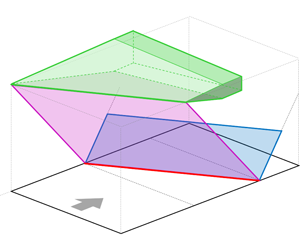Crossref Citations
This article has been cited by the following publications. This list is generated based on data provided by
Crossref.
Padmanabhan, Sathyan
Castro Maldonado, Jorge
Threadgill, James A.
and
Little, Jesse C.
2020.
Root Influence on the Unsteady Characteristics of Swept Impinging Oblique SBLIs.
Khan, Md. Raihan Ali
and
Hasan, A. B. M. Toufique
2021.
Design and Evaluation of Generic Bump for Flow Control in a Supersonic Inlet Isolator.
Journal of Fluids Engineering,
Vol. 143,
Issue. 5,
Threadgill, James A. S.
and
Little, Jesse C.
2022.
Volumetric study of a turbulent boundary layer and swept impinging oblique SBLI at Mach 2.3.
Experiments in Fluids,
Vol. 63,
Issue. 9,
Padmanabhan, Sathyan
Threadgill, James A.
and
Little, Jesse C.
2022.
Flow Similarity in Swept Shock/Boundary Layer Interactions.
Threadgill, James A.
Jouannais, Lucas
Hader, Christoph
Flood, John
Craig, Stuart A.
Fasel, Hermann F.
and
Little, Jesse C.
2022.
Fin-induced Shock Boundary Layer Interactions on a Flat Plate and Hollow Cylinder at Mach 5.
Larsson, Johan
Kumar, Vedant
Oberoi, Nikhil
Renzo, Mario Di
and
Pirozzoli, Sergio
2022.
Large-Eddy Simulations of Idealized Shock/Boundary-Layer Interactions with Crossflow.
AIAA Journal,
Vol. 60,
Issue. 5,
p.
2767.
Di Renzo, Mario
Oberoi, Nikhil
Larsson, Johan
and
Pirozzoli, Sergio
2022.
Crossflow effects on shock wave/turbulent boundary layer interactions.
Theoretical and Computational Fluid Dynamics,
Vol. 36,
Issue. 2,
p.
327.
Brouwer, Kirk R.
Perez, Ricardo
Beberniss, Timothy J.
and
Spottswood, Stephen M.
2023.
Aeroelastic Experiments and Companion Computations Assessing the Impact of Impinging Shock Sweep.
Sabnis, Kshitij
and
Babinsky, Holger
2023.
A review of three-dimensional shock wave–boundary-layer interactions.
Progress in Aerospace Sciences,
Vol. 143,
Issue. ,
p.
100953.
Yang, Shu-zi
Xie, Wen-zhong
Wang, Zhen-yu
Hu, Jun
and
Guo, Shengmin
2023.
Generalized Scaling Analysis of the Separation Zone Induced by Shock Wave–Turbulent Boundary Layer Interactions.
Journal of Aerospace Engineering,
Vol. 36,
Issue. 1,
Brouwer, Kirk R.
Perez, Ricardo
Beberniss, Timothy J.
and
Spottswood, S. M.
2023.
Surface Pressure Measurements and Predictions in Shock-Dominated Flows.
Mosele, John-Paul
Gross, Andreas
and
Slater, John
2023.
Numerical Investigation of Asymmetric Mach 2.5 Turbulent Shock Wave Boundary Layer Interaction.
Aerospace,
Vol. 10,
Issue. 5,
p.
417.
Bergier, Thomas
Gojon, Romain
Gressier, Jérémie
Jamme, Stéphane
and
Joly, Laurent
2023.
Spectral analysis of swept shock-boundary layer interaction.
Bergier, Thomas
Gojon, Romain
Fiore, Maxime
Gressier, Jérémie
Jamme, Stéphane
and
Joly, Laurent
2023.
Sweep effects on a canonical shock wave/boundary layer interaction.
International Journal of Heat and Fluid Flow,
Vol. 104,
Issue. ,
p.
109227.
Padmanabhan, Sathyan
Jouannais, Lucas
Threadgill, James A.
and
Little, Jesse C.
2023.
Laminar/Transitional Fin-induced Shock Wave Boundary-Layer Interactions at Mach 5.
Dooner, Dylan D.
Giannelis, Nicholas F.
and
Neely, Andrew J.
2024.
Design of a wind tunnel model to investigate hypersonic double-swept shock boundary layer interaction.
Vitols, Max
Groves, Jesse R.
Threadgill, James A.
and
Little, Jesse C.
2024.
Mean Flow Characterization of Swept Shock/Boundary Layer Interactions: Isolating the Influence of Sweep.
Castillo Gomez, Luz E.
and
Gross, Andreas
2025.
Numerical Investigation of Swept Turbulent Shockwave Boundary Layer Interactions.
Aerospace Science and Technology,
p.
110185.
Vitols, Max Z.
Groves, Jesse R.
Threadgill, James A.
and
Little, Jesse C.
2025.
Mean Flow and Heat Flux Analysis of Swept Shock/Boundary Layer Interactions.
Nazir, Sana
Gowda, Kshiti
Francis, Adelbert A.
Jewell, Joseph S.
and
Poggie, Jonathan
2025.
Swept Oblique Shock/Boundary-Layer Interaction on a Sub-Boundary-Layer Bump.



